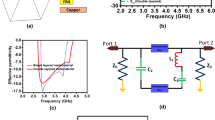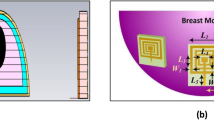Abstract
This paper presents the design, simulation and fabrication of a miniaturized wearable dual-band antenna put on a rigid substrate and operable at 2.45/5.8 GHz for wireless local area network applications. The electrical and radiation characteristics of the developed antenna were obtained by means of the technical insertion of a slot to tune the operating frequencies. To study the impact of the electromagnetic radiation of the structure of the human body, it is necessary to minimize the back radiation towards the user. Therefore, in this work, a multi-band artificial magnetic conductor (AMC) was placed directly above a dual-band planar inverted F antenna to achieve a miniaturization with excellent radiation performance. The simulations were carried out using the computer simulation technology CST Microwave Studio (CST MWS). A good agreement was achieved between the simulation and experimental results. The comparison of the measurement findings indicates that, when the antenna was backed by the AMC plane, the gain improved from 1.84 to 3.8 dB, in the lower band, and from 2.4 to 4.1 dB in the upper band. The front-to-back ratio of the AMC backed PIFA antenna was also enhanced. Then, to ensure that the proposed AMC structure is harmless to the human body, this prototype was placed on three-layer human tissue cubic model. It was observed that, due to the inclusion of an AMC plane, the peak specific absorption rate (SAR) decreased to 1.45 and 1.1 W/kg at 2.45 and 5.8 GHz, respectively (a reduction of around 3.7 W/kg, compared with an antenna without (AMC).


















Similar content being viewed by others
Availability of data and material
I confirm the transparencies of data and material.
Code availability
Not applicable.
References
Hamza, B. H., Ghnimi, S., Latrach, L., Benech, P., & Gharsallah, A. (2020). New design of multi-band PIFA antenna with reduced SAR for mobile and wireless applications. An International Journal Wireless Personal Communications, 115(2), 1211–1226.
Shakib, M. N., Moghavvemi, M., & Mahadi, W. N. L. (2015). A low-profile patch antenna for. ultrawideband application. IEEE Antennas and Wireless Propagation Letters, 14, 1790–1793.
Malekpoor, H., & Jam, S. (2015). Analysis on bandwidth enhancement of compact probe-fed patch antenna with equivalent transmission line model. IET Microwaves, Antennas & Propagation, 9(11), 1136–1143.
Varma, R., & Ghosh, J. (2019). Analysis and design of compact triple-band meandered PIFA for 2.4/5.2/5.8 GHz WLAN. IET Microwaves, Antennas & Propagation, 13(4), 505–509.
Gao, G., Yang, C., Hu, B., Zhang, R., & Wang, S. (2019). A wide-bandwidth wearable all-textile PIFA with dual resonance modes for 5 GHz WLAN applications. IEEE Transactions on Antennas and Propagation, 67(6), 4206–4211.
Domingo, P. V. D., & Raidel, L. P. (2016). Design of a dual-band PIFA for handset devices and it SAR evaluation. Engineering Research and Technology, 17(2), 169–177.
Paracha, K. N. P., Abderahim, S. K. A., Soh, P. J., Kamarudin, M. R., Tan, K., Lo, Y. C., & Islam, M. T. (2019). A low profile, dual-band, dual polarized antenna for indoor/outdoor wearable application. IEEE Access, 7, 33277–33288.
Linot, F., Begaut, X., Soiron, M., Renard, C., & Labeyrie, M. (2009). Characterization of a loaded high impedance surface. International Journal of Microwave and Wireless Technologies, 1(6), 483–487.
Jiang, Z. H., Brocker, D. E., Sieber, P. E., & Werner, D. H. (2014). A compact, low-profile metasurface-enabled antenna for wearable medical body-area network devices. IEEE Transactions on Antennas and Propagation, 62(8), 4021–4030.
Abirami, B. S., & Sundarsingh, E. F. (2017). EBG-Backed Flexible Printed Yagi-Uda Antenna for On-Body Communication. IEEE Transactions on Antennas and Propagation, 65(7), 3762–3765.
Velan, S. (2015). Dual-band EBG integrated monopole antenna deploying fractal geometry for wearable applications. IEEE Antennas and Wireless Propagation Letters, 14, 249–252.
Yan, S., Soh, P. J., & Vandenbosch, G. A. E. (2014). Low-profile dual-band textile antenna with artificial magnetic conductor plane. IEEE Transactions on Antennas and Propagation, 62(12), 6487–6490.
Lee, H., Tak, J., & Choi, J. (2017). Wearable antenna integrated into military berets for indoor/outdoor positioning system. IEEE Antennas and Wireless Propagation Letters, 16, 1919–1922.
Belhadef, Y., & Hacene, N. B. (2011). Design of new multiband slotted PIFA antennas. International Journal of Computer Science, 8(4), 325–330.
Ghorbani, A., Ansarizadeh, M., & Abdalhameed, A. (2010). Bandwidth limitations on linearly polarized microstrip antennas. IEEE Transactions on Antennas and Propagation, 58(2), 250–257.
Hamza, B. H., Ghnimi, S., Latrach, L., & Gharsallah, A. (2019). Analysis and design of a new PIFA antenna for the wireless communications applications. In The 19th IEEE mediterranean microwave symposium, pp. 1–5.
Laheurte, J. M. (2011). Compact antennas for wireless communications and terminals. Theory and Design. Wiley, ISBN: 978-1-118-60340-6, pp. 153–160.
Chattha, H. T. (2012). A comprehensive parametric study of planar inverted-F antenna. Wireless Engineering and Technology, 3(1), 1–11.
Pimenta, M. S. (2014). Flexible antenna based artificial magnetic conductors for geolocation systems. University of Nice Sophia Antipolis, Nice. https://tel.archives-ouvertes.fr/tel-00923200/document.
Gao, G. P., Yang, C., Hu, B., Zhang, R. F., & Fei, W. S. (2019). A wearable PIFA with an all-textile meta surface for 5 GHz WBAN applications. IEEE antennas and wireless propagation letters, 18(2), 288–292.
Zhang, X., Teng, Z., Liu, T. Z., & Li, B. (2015). A dual band patch antenna with a pinwheel-shaped slots EBG substrate. International Journal Antennas Propagation, 2015, 1–8.
Gao, G. P., Hu, B., Wang, S. F., & Yang, C. (2018). Wearable circular ring slot antenna with EBG structure for wireless body area network. IEEE Antennas and Wireless Propagation Letters, 17, 434–437.
Agarwal, K., Guo, Y. X., & Salam, B. (2016). Wearable AMC backed near-endfire antenna for on-body communications on latex substrate. IEEE Transactions on Components, Packaging and Manufacturing Technology., 6(3), 346–358.
Zhu, X. Q., Guo, Y. X., & Wu, W. (2015). A compact dual-band antenna for wireless body-area network applications. IEEE Antennas and Wireless Propagation Letter, 15, 98–101.
Velan, S., Sundarsingh, E. F., Kanagasabai, M., Sarma, A. K., Raviteja, C., Sivasamy, R., & Pakkathillam, J. K. (2015). Dual-band EBG integrated monopole antenna deploying fractal geometry for wearable applications. IEEE Antennas and Wireless Propagation Letters, 14, 249–252.
Author information
Authors and Affiliations
Contributions
The ethics approval, the consent to participate and the consent for publication between authors (Yes, compatibility is present).
Corresponding author
Ethics declarations
Conflict of interest
The authors have no conflicts of interest including financial interest.
Additional information
Publisher's Note
Springer Nature remains neutral with regard to jurisdictional claims in published maps and institutional affiliations.
Rights and permissions
About this article
Cite this article
Hamadi, H.B., Ghnimi, S., Latrach, L. et al. Analysis of the Electromagnetic Absorption in a New Design of PIFA Antenna Using Metamaterials. Wireless Pers Commun 124, 1337–1354 (2022). https://doi.org/10.1007/s11277-021-09409-9
Accepted:
Published:
Issue Date:
DOI: https://doi.org/10.1007/s11277-021-09409-9




